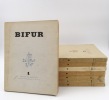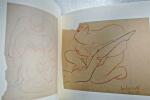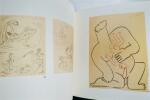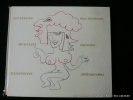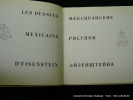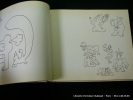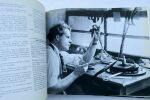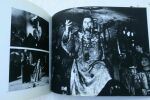59 books for « eisenstein »Edit
-
Type
Book (57)
Magazine (2)
-
Latest
Last 3 days (1)
Last week (1)
-
Language
French (58)
Russian (1)
-
Century
19th (6)
20th (19)
21st (1)
-
Countries
Belgium (6)
Denmark (6)
France (39)
Italy (2)
Switzerland (5)
United States of America (1)
-
Syndicate
ILAB (25)
SLAM (17)
Topics
- Anthology (1)
- Bory jean louis (1)
- Cinema (26)
- Eisenstein (57)
- Film-maker (6)
- Ivan the terrible (1)
- Kafka franz (1)
- Literary review (1)
- Literature (1)
- Lo duca (1)
- Man ray (1)
- Mexico mayas (1)
- Potemkine (2)
- Printing (1)
- Reliure (1)
- Review (3)
- Reviews (2)
- Robbe-grillet alain (1)
- Russia (4)
- Russian literature (1)
- Russian theatre (1)
- Theatre (2)
- Translation (1)
- Ussr (3)
- War (1)
Nachtrag zum cubischen Reciprocitätssatze für die aus dritten Wurzeln der Einheit zusammengesetzten complexen Zahlen. Criterien des cubischen Characters der Zahl 3 und ihrer Theiler (+) Transformations remarquables de quelques séries (+) La loi de réc... - [""THERE HAVE BEEN ONLY THREE EPOCH-MAKING MATHEMATICIANS: ARCHIMEDES, NEWTON, AND EISENSTEIN""]
Berlin, G. Reimer, 1844. 4to. In ""Journal für die reine und angewandte Mathematik, 28 Band, 1 Heft, 1844"". In the original printed wrappers, without backstrip. Fine and clean. [Eisenstein:] Pp. 28-35" Pp. 36-43 Pp. 44-48 Pp. 49-52" Pp. 53-67. [Entire issue: IV, 96, (2) pp. + 2 folded plates.].
First printing of six exceedingly influential papers by the German mathematics prodigy Eisenstein. Even though he died prematurely at the age of 29, he managed to prove biquadratic reciprocity, Quartic reciprocity (Presented in the present: ""Lois de réciprocité""), Cubic reciprocity (Presented in the present: ""Nachtrag zum cubischen Reciprocitätssatze...""), to be imprisoned by the Prussian army for revolutionary activities in Berlin and making Gauss state that: ""There have been only three epoch-making mathematicians: Archimedes, Newton, and Eisenstein"". Alexander von Humboldt, then 83, accompanied Eisenstein's remains to the cemetery. The papers presented in the present issue is among his most prominent and made him famous throughout the mathematical world. (James, Driven to innovate, P. 88). ""The twenty-seventh and twenty-eighth volumes of Crelle's Journal, published in 1844, contained twenty-five contributions by Eisenstein. These testimonials to his almost unbelievable, explosively dynamic productivity rocketed him to fame throughout the mathematical world. They dealt primarily with quadratic and cubic forms, the reciprocity theorem for cubic residues, fundamental theorems for quadratic and biquadratic residues, cyclotomy and forms of the third degree, plus some notes on elliptic and Abelian transcendentals. Gauss, to whom he had sent some of his writings, praised them very highly and looked forward with pleasure to an announced visit. In June 1844, carrying a glowing letter of recommendation from Humboldt, Eisenstein went off to see Gauss. He stayed in Göttingen fourteen days. In the course of the visit he won the high respect of the ""prince of mathematicians,"" whom he had revered all his life. The sojourn in Göttingen was important to Eisenstein for another reason: he became friends with Moritz A. Stern-the only lasting friendship he ever made. While the two were in continual correspondence on scientific matters, even Stern proved unable to dispel the melancholy that increasingly held Eisenstein in its grip. Even the sensational recognition that came to him while he was still only a third-semester student failed to brighten Eisenstein's spirits more than fleetingly. In February 1845, at the instance of Ernst E. Kummer, who was acting on a suggestion from Jacobi (possibly inspired by Humboldt), Eisenstein was awarded an honorary doctorate in philosophy by the School of Philosophy of the University of Breslau.Eisenstein soon became the subject of legend, and the early literature about him is full of errors. His treatises were written at a time when only Gauss, Cauchy, and Dirichlet had any conception of what a completely rigorous mathematical proof was. Even a man like Jacobi often admitted that his own work sometimes lacked the necessary rigor and self-evidence of methods and proofs."" (DSB)
Einfacher Beweis und Verallgemeinerung des Fundamentaltheorems für die biquadratischen Reste (+) Geometrischer Beweis des Fundamentaltheorems für die quadratischen Reste.
Berlin, G. Reimer, 1844. 4to. In ""Journal für die reine und angewandte Mathematik, 28 Band, 3. Heft, 1844"". In the original printed wrappers, without backstrip. Last leaf with repair. Fine and clean. [Eisenstein:] Pp. 223-245"" Pp. 246-247. [Entire issue: 193-288, (2), + two folded plates.]
First printing of two important papers by the German mathematics prodigy Eisenstein. Even though he died prematurely at the age of 29, he managed to prove biquadratic reciprocity, Quartic reciprocity, Cubic reciprocity, to be imprisoned by the Prussian army for revolutionary activities in Berlin and making Gauss state that: ""There have been only three epoch-making mathematicians: Archimedes, Newton, and Eisenstein"". Alexander von Humboldt, then 83, accompanied Eisenstein's remains to the cemetery. The papers presented in the present issue is among his most prominent and made him famous throughout the mathematical world. (James, Driven to innovate, P. 88). ""The twenty-seventh and twenty-eighth volumes of Crelle's Journal, published in 1844, contained twenty-five contributions by Eisenstein. These testimonials to his almost unbelievable, explosively dynamic productivity rocketed him to fame throughout the mathematical world. They dealt primarily with quadratic and cubic forms, the reciprocity theorem for cubic residues, fundamental theorems for quadratic and biquadratic residues, cyclotomy and forms of the third degree, plus some notes on elliptic and Abelian transcendentals. Gauss, to whom he had sent some of his writings, praised them very highly and looked forward with pleasure to an announced visit. In June 1844, carrying a glowing letter of recommendation from Humboldt, Eisenstein went off to see Gauss. He stayed in Göttingen fourteen days. In the course of the visit he won the high respect of the ""prince of mathematicians,"" whom he had revered all his life. The sojourn in Göttingen was important to Eisenstein for another reason: he became friends with Moritz A. Stern-the only lasting friendship he ever made. While the two were in continual correspondence on scientific matters, even Stern proved unable to dispel the melancholy that increasingly held Eisenstein in its grip. Even the sensational recognition that came to him while he was still only a third-semester student failed to brighten Eisenstein's spirits more than fleetingly. In February 1845, at the instance of Ernst E. Kummer, who was acting on a suggestion from Jacobi (possibly inspired by Humboldt), Eisenstein was awarded an honorary doctorate in philosophy by the School of Philosophy of the University of Breslau.Eisenstein soon became the subject of legend, and the early literature about him is full of errors. His treatises were written at a time when only Gauss, Cauchy, and Dirichlet had any conception of what a completely rigorous mathematical proof was. Even a man like Jacobi often admitted that his own work sometimes lacked the necessary rigor and self-evidence of methods and proofs."" (DSB)
Allgemeine Untersuchungen über die Formen dritten Grades mit drei Variabeln, welche der Kreistheilung ihre Entstehung verdanken.
Berlin, G. Reimer, 1844. 4to. As extracted from ""Journal für die reine und angewandte Mathematik, 28 Band, 4. Heft, 1844"". Without wrappers and backstrip. Fine and clean. [Eisenstein:] Pp. 289-374. [Entire issue: 289-380 + 2 folded plates].
First printing of German mathematics prodigy Eisenstein's paper on third degree equations with basis in a devided circle. Even though he died prematurely at the age of 29, he managed to prove biquadratic reciprocity, Quartic reciprocity, Cubic reciprocity, to be imprisoned by the Prussian army for revolutionary activities in Berlin and making Gauss state that: ""There have been only three epoch-making mathematicians: Archimedes, Newton, and Eisenstein"". Alexander von Humboldt, then 83, accompanied Eisenstein's remains to the cemetery. The papers presented in the present issue is among his most prominent and made him famous throughout the mathematical world. (James, Driven to innovate, P. 88). ""The twenty-seventh and twenty-eighth volumes of Crelle's Journal, published in 1844, contained twenty-five contributions by Eisenstein. These testimonials to his almost unbelievable, explosively dynamic productivity rocketed him to fame throughout the mathematical world. They dealt primarily with quadratic and cubic forms, the reciprocity theorem for cubic residues, fundamental theorems for quadratic and biquadratic residues, cyclotomy and forms of the third degree, plus some notes on elliptic and Abelian transcendentals. Gauss, to whom he had sent some of his writings, praised them very highly and looked forward with pleasure to an announced visit. In June 1844, carrying a glowing letter of recommendation from Humboldt, Eisenstein went off to see Gauss. He stayed in Göttingen fourteen days. In the course of the visit he won the high respect of the ""prince of mathematicians,"" whom he had revered all his life. The sojourn in Göttingen was important to Eisenstein for another reason: he became friends with Moritz A. Stern-the only lasting friendship he ever made. While the two were in continual correspondence on scientific matters, even Stern proved unable to dispel the melancholy that increasingly held Eisenstein in its grip. Even the sensational recognition that came to him while he was still only a third-semester student failed to brighten Eisenstein's spirits more than fleetingly. In February 1845, at the instance of Ernst E. Kummer, who was acting on a suggestion from Jacobi (possibly inspired by Humboldt), Eisenstein was awarded an honorary doctorate in philosophy by the School of Philosophy of the University of Breslau.Eisenstein soon became the subject of legend, and the early literature about him is full of errors. His treatises were written at a time when only Gauss, Cauchy, and Dirichlet had any conception of what a completely rigorous mathematical proof was. Even a man like Jacobi often admitted that his own work sometimes lacked the necessary rigor and self-evidence of methods and proofs."" (DSB)
Théorèmes sur les Formes cubiques et Solution d'une Equation du quatrième Degré à quatre indéterminées (+) Über die Anzahl der quadratischen Formen, welche in der Theorie der complexen Zahlen zu einer reellen Determinante gehören (+) Allgemeine Auflös... - [""THERE HAVE BEEN ONLY THREE EPOCH-MAKING MATHEMATICIANS: ARCHIMEDES, NEWTON, AND EISENSTEIN""]
Berlin, G. Reimer, 1844. 4to. In contemporary half cloth. In ""Journal für die reine und angewandte Mathematik"", 27. band, Heft 1-4, 1844. Entire volume 27 offered. A small library stamp to lower part of p. 1 and a white label pasted on to upper part of spine. Light occassional brownspotting, otherwise fine and clean.
First printing of these influential papers by the German mathematics prodigy Eisenstein. Even though he died prematurely at the age of 29, he managed to prove Cubic reciprocity (presented in the present papers) biquadratic reciprocity, Quartic reciprocity, to be imprisoned by the Prussian army for revolutionary activities in Berlin and making Gauss state that: ""There have been only three epoch-making mathematicians: Archimedes, Newton, and Eisenstein"". Alexander von Humboldt, then 83, accompanied Eisenstein's remains to the cemetery. The papers presented in the present issue is among his most prominent and made him famous throughout the mathematical world. (James, Driven to innovate, P. 88). ""The twenty-seventh (the present and most extensive) and twenty-eighth volumes of Crelle's Journal, published in 1844, contained twenty-five contributions by Eisenstein. These testimonials to his almost unbelievable, explosively dynamic productivity rocketed him to fame throughout the mathematical world. They dealt primarily with quadratic and cubic forms, the reciprocity theorem for cubic residues, fundamental theorems for quadratic and biquadratic residues, cyclotomy and forms of the third degree, plus some notes on elliptic and Abelian transcendentals. Gauss, to whom he had sent some of his writings, praised them very highly and looked forward with pleasure to an announced visit. In June 1844, carrying a glowing letter of recommendation from Humboldt, Eisenstein went off to see Gauss. He stayed in Göttingen fourteen days. In the course of the visit he won the high respect of the ""prince of mathematicians,"" whom he had revered all his life. The sojourn in Göttingen was important to Eisenstein for another reason: he became friends with Moritz A. Stern-the only lasting friendship he ever made. While the two were in continual correspondence on scientific matters, even Stern proved unable to dispel the melancholy that increasingly held Eisenstein in its grip. Even the sensational recognition that came to him while he was still only a third-semester student failed to brighten Eisenstein's spirits more than fleetingly. In February 1845, at the instance of Ernst E. Kummer, who was acting on a suggestion from Jacobi (possibly inspired by Humboldt), Eisenstein was awarded an honorary doctorate in philosophy by the School of Philosophy of the University of Breslau.Eisenstein soon became the subject of legend, and the early literature about him is full of errors. His treatises were written at a time when only Gauss, Cauchy, and Dirichlet had any conception of what a completely rigorous mathematical proof was. Even a man like Jacobi often admitted that his own work sometimes lacked the necessary rigor and self-evidence of methods and proofs."" (DSB).
CROQUIS DE THÉÂTRE (Edition en trois langues: russe, anglais, français): avec 30 croquis polychromes.
Association des cinéastes de l’URSS, Moscou, 1970
Un portefolio in-plano (36 x46 cm) couverture rigide et toilée de couleur mastic avec un 1er plat orné (un Arlequin en couleur dessiné par EISENSTEIN surmontant le titre de cet ouvrage en russe (probablement “30 croquis d’EiSENSTEIN”). A l’intérieur du portefolio on trouve d’abord une page volante en russe et en anglais présentant en quelques lignes le présent ouvrage, signées SERGUEI YUTKEVITCH: il explique qu’il s’agit de la reproduction en facsimilés des dessins du grand réalisateur S.M. EISENSTEIN “ dont le nom n’a besoin d’aucun commentaire ni publicité” ... On trouve ensuite 6 pages de texte agrafées, écrites en trois langues, signées elles aussi de l’auteur SERGUEI YOUTKEVITCH . La version française évoque évidemment EISENSTEIN et sa passion pour le dessin. YOUTKEVITCH a été ami de S.M EISENSTEIN qu’il a rencontré à l’école du grand metteur en scaène MEYERHOLD en 1921. Ensemble ils ont conçu des décors pour ce dernier. Au dos de ces 6 pages on trouve la liste des 30 croquis d’EISENSTEIN qui sont exclusivement des croquis de théâtre, des années 1917-1922, sauf les deux derniers croquis qui datent de 1942 et 1944.Ces 30 croquis sont complets,. Il s’agit de superbes reproduction couleurs légèrement contrecollées sur des support en carton assez fort. Ils témoignent du grand talent de dessinateur d’EISENSTEIN dont on voit bien qu’il participait au grand mouvement des grands graphistes et peintres de l’époque, avant de devenir le grand cinéaste que l’on sait. Notre exemplaire , dans doute une édition originale vu sa qualité, est en TRES BON ETAT.
Beiträge zur Theorie der elliptischen Functionen (+) Notiz über Partialbrüche,
Berlin, G. Reimer, 1846. 4to. In ""Journal für die reine und angewandte Mathematik, 33 Band, 1. Heft, 1846"". In the original printed wrappers, without backstrip. Fine and clean. Last leaf with repair. [Eisenstein:] Pp. 59-70"" Pp. 71-88. [Entire issue: IV, 92, (2) + 2 plates.].
First printing of two papers by Eisenstein, one of them (Beiträge zur Theorie...) being the first of his 1846-47-period where he mainly occupied himself with the theory of elliptic functions.Even though the German mathematics prodigy Eisenstein's died prematurely at the age of 29, he managed to prove biquadratic reciprocity, Quartic reciprocity, Cubic reciprocity, to be imprisoned by the Prussian army for revolutionary activities in Berlin and making Gauss state that: ""There have been only three epoch-making mathematicians: Archimedes, Newton, and Eisenstein"". Alexander von Humboldt, then 83, accompanied Eisenstein's remains to the cemetery. The papers presented in the present issue is among his most prominent and made him famous throughout the mathematical world. (James, Driven to innovate, P. 88). The issue also contain papers by famous contemporary mathematicians such as: C. G J. Jacobi, A. Cayley, Dirichlet and J. Steiner.""Eisenstein soon became the subject of legend, and the early literature about him is full of errors. His treatises were written at a time when only Gauss, Cauchy, and Dirichlet had any conception of what a completely rigorous mathematical proof was. Even a man like Jacobi often admitted that his own work sometimes lacked the necessary rigor and self-evidence of methods and proofs."" (DSB)
"Eisenstein Sergei Eisenstein Y. Pimenov M. Myasnikov Olga Asienstat"
Reference : 9830
(1961)
"Dessins Eisenstein"
"1961. Moscou Éditions Iskustvo 1961 - Cartonné toilé 23 cm x 29 cm 227 pages - Textes en russe français anglais et allemand de Sergei Eisenstein Y. Pimenov M. Myasnikov Olga Asienstat - Nombreuses ills couleurs et N&B in et hors-texte de Sergei Eisenstein - Très bon état"
Ciné-Club - Organe de la Fédération Française des Ciné-Clubs (S. M. Eisenstein)Président : Jean Painlevé
Reference : 50267
Ciné-Club S. M. Eisenstein 1898-1948. Sur le style d'Eisenetein (Jean Mitry) / Une force prodigieusement vivante (Alexandre Arnoux) / Permanence d'un style (Léon Barsacq) / S. M. Eisenstein, Le patriotisme est mon thème / Le contre-point "son-image" (Armand Panigel) / Notes au sujet d'Alexandre Nevsky (Henri Fescourt) / L'oeuvre d'Eisenstein (G. Sadoul) / La révélation du Potemkine (Georges Altman) - ...
N° 5 - mars 1948 - Redaction, Administration : 2, rue de l'Elysée. Paris-8e - Journal illustré
bon état
S. M. EISENSEIN oeuvres complètes 120 diapositives collection Avant-Scène du Cinéma
Avant-Scène du Cinéma 4° Emboitage in 4° 120 Un emboitage in 4° contenant 120 diapositives résumant l'oeuvre dde S. M. Eisenstein Peu courant, il n'y a aucune indication de tirage, mais l'objet même exclu une grande diffusion. Poids avant emballage plus de 1 kg. Envoi via colissimo valeur déclarée 12
Sergueï Mikhaïlovitch Eisenstein (en russe : ), parfois désigné ou crédité sous les formes Sergueï Eisenstein, Sergueï M. Eisenstein ou S. M. Eisenstein, est un cinéaste et théoricien du cinéma soviétique né le 10 janvier 1898 (22 janvier dans le calendrier grégorien)1,2 à Riga (gouvernement de Livonie, dans l'Empire russe, aujourd'hui Lettonie) et mort le 11 février 1948 à Moscou.Il est souvent considéré comme un des « pères du montage » avec D. W. Griffith et Abel Gance. (Wikipédia) Dos déboité comme on peut le voir sur la photo n° 2, bon état pour le reste Remises possibles sur les achats en lot, achetez plusieurs objets à la fois ! Reçoit sur rendez-vous pour consultation des ouvrages.
Über die Irreductibilität und einige andere Eigenschaften der Gleichung, von welcher die Theilung der ganzen Lemniscate abhängt (+) Über eine allgemeine Eigenschaften der Gleichung, von welcher die Theilung der ganzen Lemniscate abhängt, nebst Anwendu... - [Eisenstein's Criterion]
Berlin, G. Reimer, 1850. 4to. Bound in later marbled wrappers, as extracted from ""Journal für die reine und angewandte Mathematik, 28 Band, 4. Heft, 1844"". Very fine and clean. Pp. 160-179" Pp. 224-274 Pp. 275-287 [Entire issue: 289-380 + 2 folded plates].
First publication of lemniscate function and Eisenstein's Criterion, one of the best known irreducibility criteria of polynomials. It is often seen referred to as the Schönemann-Eisenstein. Euler had introduced and studied the arc length of the lemniscate in the 18th century, this work laying the ground work for the later development of elliptic functions. The lemniscate function expresses the parameter of the lemnicate in terms of its arc-length. It can be extended to complex values of the parameter, and it then makes sense to ask for the points which divide the lemniscate into m equal parts, where m is a Gaussian integer (a complex number). Abel had shown that the determination of these points reduced to finding the roots of a certain polynomial equation. A crucial point in Eisenstein's extension of Abel's work described in the present papers was to prove that this polynomial is irreducible. Eisenstein developed his eponymous criterion to establish this (although today it is most familiar when applied to the more elementary case of a polynomial with ordinary integer coefficients).
Serguei M. Eisenstein "Croquis de théâtre"
Moscou, Union cinématographique d'URSS, 1970. In-plano, 9 pp. + 26 pl., broché pour le livret, en feuilles pour les planches, étui éditeur illustré (taches et accidents à l'étui).
Recueil de 30 reproductions en couleurs de croquis de décors et costumes de théâtre du célèbre cinéaste soviétique Sergei Eisenstein. Elles sont montées sur papier fort gris et sont accompagnées d'un livret explicatif en russe, anglais et français, illustré de quelques reproductions en noir. Un des 1000 exemplaires tirés. Ouvrage peu commun. * Membre du SLAM et de la LILA / ILAB Member. La librairie est ouverte du lundi au vendredi de 14h à 19h. Merci de nous prévenir avant de passer,certains de nos livres étant entreposés dans une réserve.
RIBEMONT-DESSAIGNES, GOLL (Ivan), MICHAUX (Henry), SOUPAULT (Philippe), TZARA (Tristan), LURCAT (Jean), KRULL (Germaine), KERTESZ (André), LOTAR (Eli), MOHOLO-NAGY, TABARD (Maurice), CHIRICO (Giorgio de), PICABIA (Francis), GIONO (Jean), LEIRIS (Michel), ALTMAN (Nathan), DESNOS (Robert), BUNUEL, MAN RAY, JOYCE (James), KAFKA (Franz), ARP (Hans), VITRAC (Roger), HELLENS (Franz), EISENSTEIN, PARAIN (Brice), DRIEU LA ROCHELLE, PREVERT (Jacques), DABIT (Eugène)
Reference : 13163
BIFUR 1-8.
Paris, Editions du Carrefour, 1929-1931. 8 volumes in-4, brochés (dos passés, petit manque à la couverture du vol. 4). / Eight 4to volumes, softcovers (sunned backs, one minute lack of paper on the cover of vol. 4).
La collection complète de cet importante revue d'avant-garde. Défauts aux couverture, mais bon exemplaire.Textes par Tzara, Cendrars, Sartre, Chirico, etc. et images par Krull, Kertesz, Moholy-Nagy, Tabard, Eisenstein, Eli Lotar, L. Bunuel... /// The complete collection of this important avant-garde journal. Texts by Tzara, Cendrars, Sartre, Chirico, etc. and pictures by Krull, Kertesz, Moholy-Nagy, Tabard, Eisenstein, Eli Lotar, L. Bunuel... * Voir photographies / See pictures. * Membre du SLAM et de la LILA / ILAB Member. La librairie est ouverte sur rendez-vous.
Recherches soviétiques n°3- Avril 1956-Sommaire: Présentation par G. Sadoul- Problèmes de la composition par S. Eisenstein- Le travail de l'acteur de cinéma et le système de Stanislavsky par Poudovkine V.,- La parole dans le scénario- Littérature et ciném
De la nouvelle Critique. 1956. In-8. Broché. Etat d'usage, Couv. défraîchie, Dos plié, Non coupé. 201 pages. Nombreuses photos en noir et blanc, in et hors texte. Coins frottés, déchirés. Papier jauni.. . . . Classification Dewey : 791.43-Cinéma
Sommaire: Présentation par G. Sadoul- Problèmes de la composition par S. Eisenstein- Le travail de l'acteur de cinéma et le système de Stanislavsky par Poudovkine V.,- La parole dans le scénario- Littérature et cinéma- Les traditions classiques et le film comique- etc. Classification Dewey : 791.43-Cinéma
Dessins Secrets.
Paris Le Seuil 1999 Un volume in-8 à l'italienne pleine toile noire de l'éditeur, 190 pages, reproduction de 152 dessins érotiques du réalisateur Eisenstein. Bel état.
La librairie est ouverte du mardi au samedi de 9h30 à 12h30 et de 13h30 à 19h00. Commandes par courriel ou téléphone. Envoi rapide, emballage soigné.
Réflexions d'un cinéaste.
1947 1947 Editions en langues étrangères, Moscou, 1958. In-4 pleine toile, 223 pages. Avec des dessins d'Eisenstein. Bon état.
La librairie est ouverte du mardi au samedi de 9h30 à 12h30 et de 13h30 à 19h00. Commandes par courriel ou téléphone. Envoi rapide, emballage soigné. La librairie est ouverte du mardi au samedi de 9h30 à 12h30 et de 13h30 à 19h00. Commandes par courriel ou téléphone. Envoi rapide, emballage soigné.
Dessins secrets
Eisenstein, Serguei MikhailovitchDessins secrets, avec des textes de J. C. Marcadé & G. AckermanSEUIL, 1999, in 4° petit, belle reliure toilée, 189 pp.Très bel exemplaire
L'Avant Scène Cinéma N°74 Octobre
1962 Paris, avant-scène ,1962, 18 x 27cm ,86 pp, très bon état,
Très bon état.
L'Avant Scène Cinéma N° 50 -51 Ivan le Terrible I Ivan le Terrible II Ivan le Terrible III
1965 Paris, avant-scène ,1965, 18 x 27cm , 98 pp, très bon état,
Très bon état.
Risunki. In Russian /Sketches
Short description: In Russian. Eisenstein, Sergei Mikhailovich. Drawings. Moscow: Art, 1961. The image is provided for reference only. It may reflect condition of one of the available copies or only help in identifying the edition. Please feel free to contact us for a detailed description of the copies available. SKU6372199
ZERVOS, Christitan (Directeur). - MUHLSTEIN, Hans. - TERIADE, E. - LONGHURST, M. - EISENSTEIN, S. M. - GIEDION, S.
Reference : 73530
Cahiers d’Art, n.° 2, 5e année, 1930. Revue d’art paraissant dix fois par an. Peinture, sculpture, architecture, art ancien, ethnographie, cinéma. Des origines de l’art et de la culture, par Hans Muhlstein. Documentaire sur la jeune peinture, par E. Tériade. Quatre colonnes avec chapiteaux sculptés du XIIe siècle, par M. Longhurst. Le principe cinématographique et la civilisation japonaise, par S. M. Eisenstein. Walter Gropius et l’architecture allemande par S. Giedion. Les expositions. Les livres.
Paris, Editions “Cahiers d’Art” 1930, 315x245mm, broché. Déchirures sur le haut et le bas du dos, autrement bel exemplaire.
pages 57 à 112, planches en n/b, Pour un paiement via PayPal, veuillez nous en faire la demande et nous vous enverrons une facture PayPal
Anthologie du Cinéma : Eisenstein (Traduction et notes de Luda Schnitzer) (Rostislav Yourenev)
n° 1 - 1965 - supplément à l'avant scène du cinéma N° 44 - broché - 62 pages
Bon état
The Film Sense.
London Faber and Faber 1986 1 vol. broché in-8, broché, couverture illustrée, 228 pp., schémas en noir, index. Texte en anglais. Bon état. Exemplaire provenant de la bibliothèque d'Alain Resnais.
Two Films.
London Lorrimer Publishing, coll. "Classic Film Scripts" 1984 1 vol. broché in-8, broché, couverture illustrée, 150 pp., quelques photos en noir. Scripts de October et Alexander Nevsky. Texte en anglais. Très bon état. Exemplaire provenant de la bibliothèque d'Alain Resnais.
Préface de I. Karetnikova. Présentation de L. Steinmets. S. Eisenstein.
Reference : 73685
(1968)
Les dessins mexicains d'Eisenstein
Moscou, Editions Sovietski Khoudojnik, 1968, in-4 à l'italienne, cartonnage éditeur, 128 pages. Accrocs en tête et pied du dos, coins frottés. Bon exemplaire. Texte français/russe.
NB Le délai d'acheminement vers la France est de 48h.
 Write to the booksellers
Write to the booksellers


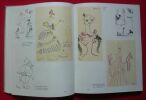
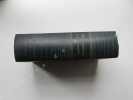
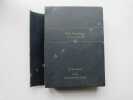
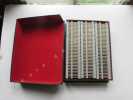
![Serguei M. Eisenstein "Croquis de théâtre". [EISENSTEIN (Serguei)]; YOUTKEVITCH (Serguei)](https://static.livre-rare-book.com/pictures/TVX/20176_1_thumb.jpg)
![Serguei M. Eisenstein "Croquis de théâtre". [EISENSTEIN (Serguei)]; YOUTKEVITCH (Serguei)](https://static.livre-rare-book.com/pictures/TVX/20176_2_thumb.jpg)
![Serguei M. Eisenstein "Croquis de théâtre". [EISENSTEIN (Serguei)]; YOUTKEVITCH (Serguei)](https://static.livre-rare-book.com/pictures/TVX/20176_3_thumb.jpg)
